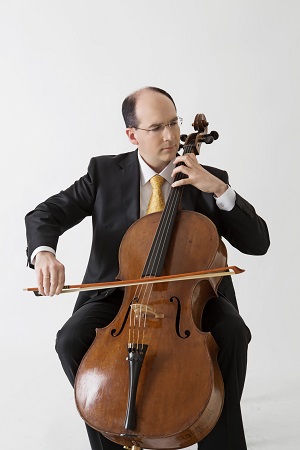 United States Pärt, Britten, Herbert, Dvořák, Enescu: Mark Kosower (cello), Canton Symphony Orchestra / Gerhardt Zimmermann (conductor), Umstattd Performing Arts Hall, Canton, Ohio. 27.10.2018. (TW)
United States Pärt, Britten, Herbert, Dvořák, Enescu: Mark Kosower (cello), Canton Symphony Orchestra / Gerhardt Zimmermann (conductor), Umstattd Performing Arts Hall, Canton, Ohio. 27.10.2018. (TW)

Pärt – Cantus in Memory of Benjamin Britten
Britten – Sinfonia da Requiem
Victor Herbert – Cello Concerto No.2 in E Minor
Dvořák – Rondo for Cello and Orchestra in G Minor
Enescu – Romanian Rhapsody No.1 in A Major
After this eclectic program by the Canton Symphony Orchestra at Umstattdt Performing Arts Hall, I was finally convinced: Every member of this ensemble, including Maestro Gerhardt Zimmermann, is an alchemist. What else could explain the transmutation of the instruments they play and the scores they read into vessels of such profound spirituality?
This phenomenon was evident in Arvo Pärt’s 1977 Cantus in Memory of Benjamin Britten for string orchestra, composed as a memorial to the leading British composer of the mid-20th century, who had died a year earlier. Pärt was greatly moved by what he called Britten’s ‘unusual purity’.
Seemingly mesmerized by its hypnotic simplicity, the Canton players articulated an utterly ethereal reality. At the beginning, a solitary tubular bell rings out three times, followed by the whispered entry of very high violins that introduce the haunting melody. Like a rolling mist, that single motif descends progressively into lower registers from violins to violas, then to cellos, then to the basses, and all against the ceaseless tolling of the bell. Most intriguing is how gradually through time the tempo slows while the volume of sound increases to a roar until, at its loudest point, it suddenly stopped.
At the end, the musicians offered one more bell, softly ringing and fading away into breathtaking, mystical quiet. It was silence with a pulse — a poignant arrival at reverential, even tearful introspection.
Pärt’s calm prefaced the stormy opening of Britten’s Sinfonia Da Requiem, composed in 1940. An avowed pacifist, the composer was commissioned by the Japanese government (at that time engaged in war with China) to commemorate 2,600 years of Japan’s ruling Mikado dynasty. But perhaps the Japanese didn’t fully comprehend the implications when they initially approved the title, since after a rehearsal in Tokyo, the score was rejected. The angry Japanese foreign ministry found the Christian liturgical references disturbing and otherwise culturally inappropriate, and there are no references to the Japanese dynastic anniversary.
The Sinfonia’s three movements have no liturgical specificity, but in their intense emotional trajectory, speak of Britten’s feelings about war.
It is a path replete with alternately thunderous, writhing, and lush melodies voiced in layers by every section of the orchestra, all executed here with electrifying aplomb. The first movement, ‘Lacrymosa’, began with the startling ferocity of timpani blows, sounding like cannon fire, followed by a slow lament from the brooding cellos. The frenzied second movement, ‘Dies Irae,’ ranks among Britten’s greatest feats of orchestral writing. With remarkable fervor, the orchestra conjured the full outbreak of war, symbolized by piercing flutes, snarling rapid-fire triplet figures from the trumpets, and explosive syncopations from the brass. In the third movement, ‘Requiem Aeternam’, all that grim tumult was left behind to impart a spirit of peace that concluded with a sustained, consoling note from the clarinet.
In Victor Herbert’s Cello Concerto No.2, guest soloist Mark Kosower, principal cellist of The Cleveland Orchestra, was transcendent and riveting, drawing the audience progressively deeper into the dramatic mood shifts. After the plaintive opening melody, leaping from the ensemble’s crisp, churning textures, came the wistful, heartrending journey of the second movement. And throughout the lyrical aggressiveness of the finale, with all its daunting, rapid sixteenth notes, Kosower’s mellow tonality was a constant, sensual presence, and always in perfect balance with the ensemble.
The soloist’s virtuosity was equally compelling throughout Dvořák’s Rondo for Cello and Orchestra. As an artist, Kosower’s prowess rests not only in his dazzling technical precision, but more importantly, in his ability to transform the cello into a sublimely emotive force.
Speaking of emotive forces, the evening ended with a titillating rendition of Enescu’s 1901 Romanian Rhapsody No.1. This vivacious medley of Romanian-flavored folk songs and dances was delivered with infectious abandon. While medieval alchemists failed in their attempts to create a universal potion to cure all disease, the CSO alchemists were eminently successful in concocting an elixir of pure jubilation.
Tom Wachunas